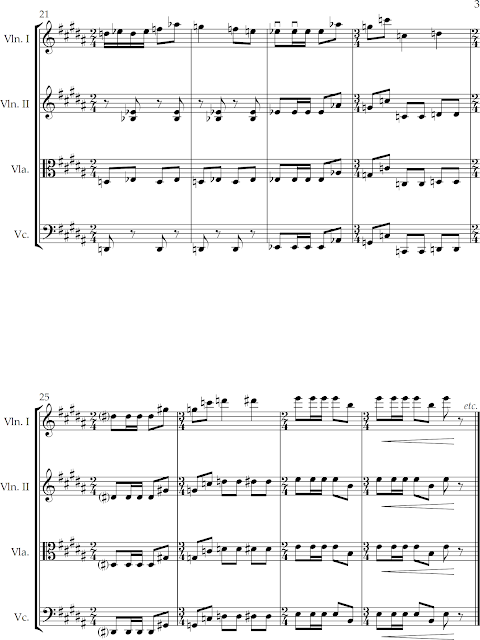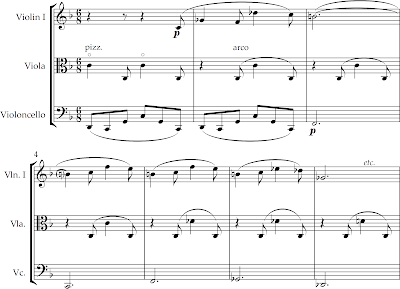DCCVIII. SHOSTAKOVICH, Dmitri (1906-1975)
In order to avoid yet another charge of formalism, Shostakovich provided Soviet-friendly titles to each movement:
- Blithe ignorance of the future cataclysm
- Rumblings of unrest and anticipation
- Forces of war unleashed
- In memory of the dead
- The eternal question of why? and for what?
Nevertheless, after the premiere by the Beethoven Quartet on December 16, 1946 the work was shelved and heard only infrequently in private performances.
First movement
A simple F Major vamp is set up in the lower strings, and the first violin enters with a jaunty, typical Shostakovich da-da-duh, da-da-duh motif.
A simple F Major vamp is set up in the lower strings, and the first violin enters with a jaunty, typical Shostakovich da-da-duh, da-da-duh motif.
The Beethoven's cellist -- Valentin Berlinsky -- recalls an amusing incident regarding these first few bars:
"Shostakovich hardly ever changed anything in his works. He was very meticulous in his fair copy. We prepared the Third Quartet to play for him. The first movement opens with the cello playing a bottom F, written arco. For some reason we decided that it sounded better played pizzicato, while the second violin and viola continue to play arco. In our youthful folly, we decided to play it like that for Dmitri Dmitriyevich without any prior warning. This took place at his home. No sooner had we started, he stopped us and said, 'Excuse me, but you are meant to play arco there.' 'Yes, but it seemed to us that pizzicato sounds better here.' 'Yes, yes,' he hastily interrupted, 'pizzicato is much better, but please play arco all the same.'"
The second theme is a simple melody that rolls up and back down:
a wonderful fugato section with staggered entrances by cello, viola, and first violin:
The second theme returns, and DS kicks up the tempo:
and vigorously pushes to the end, finishing with a sparkling perfect cadence:
Second movement
After that final V-I cadence in F Major, DS suddenly drops a semitone to the weirdly unrelated key of E Minor. (The harmonic layout of this quartet is similar to Beethoven's Op. 131).
Berlinsky:
Berlinsky:
"In general, his marking of the tempo often contradicted what he really wanted. 'We would say, but Dmitri Dmitriyevich, your metronome mark is such and such.' He'd reply, 'well, you see, my metronome at home is out of order, so pay no attention to what I wrote.'"
As the viola pounds out a brutal E Minor arpeggio (somewhat reminiscent of the third movement of the Eighth Symphony, also in E Minor), the first violin skips along the surface in dissonant contrast to the tonic. At Bar 7, the viola part switches to a first inversion B Diminished triad for six bars.
"Shostakovich conceived the idea of the First Symphony in July 1923. Probably his early Scherzo Op. 7 was initially intended as its third movement. The young composer noted, not without satisfaction, that he had provoked Steinberg's displeasure with this piece. 'What is this obsession with the Grotesque? The [Piano] Trio already was in part Grotesque. Then the cello pieces are Grotesque and finally this Scherzo is also Grotesque!' Steinberg's comments did not have much effect. The young composer went on to ridicule the traditional tenets of his teacher: 'The inviolable foundations of The Mighty Handful, the sacred traditions of Nikolai Andreevich [Rimsky-Korsakov] and other such pompous phrases. Unfortunately, I can no longer indulge him with my music'" -- (p. 45).
Wonderful independent part-writing:
A portrait of the off-balanced Stalin? A debate never to be settled, perhaps. I present the following evidence:
In C-Sharp Minor -- the relative minor of E Major -- a semitone below the quartet's tonic (F Major), which will finally reappear in the final movement.
A solemn five-bar theme is repeated seven times:
I.
The two violins exchange long tones in a short, contrapuntal passage, and the theme returns -- exactly the same as I. but the final bar is raised by a whole step:
II.
DS stretches out the theme -- now in the cello with long-tone accompaniment -- by adding an extra bar with the quintuplet:
III.
DS introduces a typical da-da-duh figure, funeral march-style. Two bars of introduction precede the theme, now in the first violin:
IV.
Increased dynamic intensity:
V.
I.
The two violins exchange long tones in a short, contrapuntal passage, and the theme returns -- exactly the same as I. but the final bar is raised by a whole step:
II.
III.
IV.
V.
VII.
This slippery, unstoppable 6/8 is filled with passing tones either just above or below the key enter and its relations:
A seductive melisma:
More development -- including a restatement of the previous A Major theme in A Minor. The pace winds down as the first violin takes up the "slippery" theme -- Adagio -- and all fades away ...











































No comments:
Post a Comment